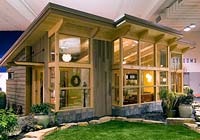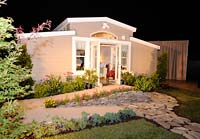Prefab 'In-law' Cottages Mix High-tech Features, Comfort
New freestanding modular home additions aim to provide the right kind of space for aging in place.

Photo courtesy of FabCab
FabCab is a timber-frame kit home with universal design features. Click photo for more information
Eric Santolicito, 35, of Billerica, Mass., had a plan for looking after his parents as they grew older: The family man bought his sixtysomething parents’ home, demolished it and put up a new prefab house with an in-law suite on the lot.
“It was a win-win situation,” Santolicito says. “We cut our expenses for owning and maintaining two separate, older homes. Now we all have a new house with separate living quarters, and we stayed in the neighborhood where my sisters live, too. My parents were able to downsize a bit. They now have living, dining, bedroom, bath and kitchen spaces in about 800 square feet — much less for them to clean and maintain. I can look after all the yard work. And now we have the best on-site child care for our two little ones.

Photo courtesy of MEDCottage
MEDCottage features options for advanced medical monitoring equipment. Click photo for more information.
See Also: Custom Prefab ADUs
“Building this house the way we did — it has alleviated a lot of stress for everyone in the family,” he says.
Not everyone is in a position to build a new home to support multigenerational families. But a number of manufactured housing producers are introducing new prefab home additions with features to support aging at home or near family members. Known in the building industry as ADUs (accessory dwelling units) and in consumer media as “granny pods” and “in-law apartments,” the new self-contained units incorporate barrier-free, universal designs and options that include electronic monitoring and medical care equipment.
All are largely built or prepared for assembly in a factory, trucked to a building site and set on a foundation, which manufacturers claim cuts construction costs and time from initiation to occupancy.
FabCab, a Seattle-based manufacturer of timber-frame kit homes, offers ADUs ranging in size from 300 to 1,800 square feet. A Salem, Va., startup called N2Care will begin manufacturing the MEDCottage — a portable ADU for temporary or extended care at home with options for high-tech medical monitoring and security equipment — in January 2011. And The Home Store — a long-established manufacturer of high-end modular homes in the Northeast — is now offering freestanding, custom-designed “in-law” units.
Are ADUs a Good Solution?
“From many angles, the ADU concept is a sound one,” says Susan M. Duncan of the National Resource Center on Supportive Housing and Home Modification at the Ethel Percy Andrus Gerontology Center at University of Southern California. “An ADU occupies the same space as an apartment but makes it into a private, freestanding home. Privacy is something we all strive for. And families are happier because the TV can be as loud as you want without disturbing the grandkids doing homework,”
Save Money: Get AARP member discounts on travel, shopping and more
Jane Marie O'Connor, of 55 Plus, LLC, in Charlemont, Mass., a building industry consultant, sees at least a potential pitfall in ADUs for those in need of care: “One key element that can still be missing would be human contact. Living in or near the home of an adult child who is likely gone all day provides little or no stimulation if there is no opportunity for socialization, which many assisted-living facilities are good at providing.”
